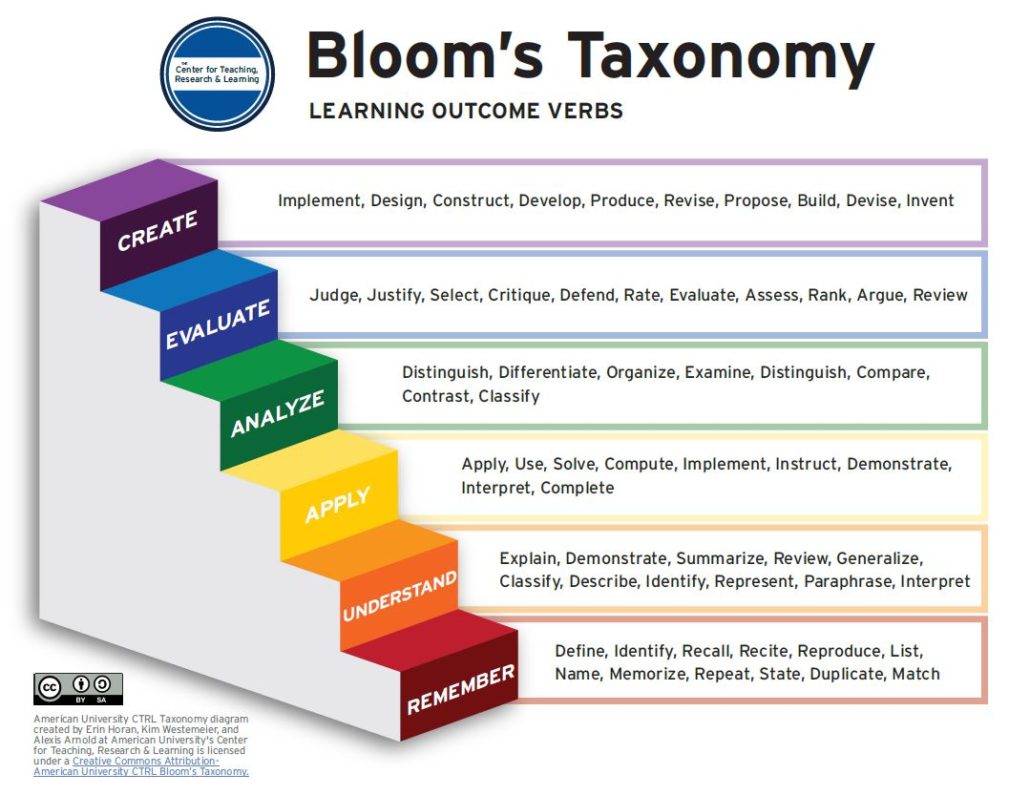Developing Student Learning Outcomes with Bloom’s Taxonomy
last edit 2021/21/1
Learning Outcomes
Student learning outcomes are measurable statements that define the knowledge and skills instructors expect students to learn and gain from their courses. Learning outcomes are useful for instructors as they help you narrow down the goals for your course, and distill these into understandable, actionable, and measurable statements. Learning outcomes help instructors prioritize course content and inform the course structure. For students, learning outcomes explicitly state what they should know and be able to do by the end of a course. They clearly define the instructor’s expectations and help students focus their studies on the most important and relevant content. Transparency and clarity are also key factors that help support student motivation and engagement in class: it’s easier to be motivated and engaged if you know what you’re supposed to do, and why you’re supposed to do it!
Learning outcomes address both course content and the skills students should develop throughout a course. For example, time management, critical thinking, problem solving, public speaking, and/or lab techniques are skills that could be included in learning outcomes. To write clear and measurable learning outcomes, it is important to use action verbs that clearly indicate what students should be doing to achieve the learning outcome, as well as the level of cognitive development you hope students will achieve.
An ineffective learning outcome may state “by the end of the session, students will learn about mitosis.” While “learn” is a verb, what does “learning” look like and how can an instructor measure it? How can students demonstrate they have “learned” mitosis? What if they learned mitosis before this class? What should they “learn” about mitosis, and how in depth should their understanding be? A revised and effective learning outcome would instead state “by the end of the session, students will be able to describe what occurs during the five stages of mitosis including how cells appear during each stage.” This outcome is much more specific, is measurable, and indicates exactly what students should be able to do. It also accounts for the possibility that some students are already familiar with the concept before the course begins, because it does not imply a starting point for students (not knowing the content) but rather growth from any starting point and working towards a concrete end goal (being able to describe the concept). It also identifies the level of cognitive development students should achieve: understanding. One useful framework for writing learning outcomes and determining the level of cognitive development required for them is Bloom’s Taxonomy.
Bloom’s Taxonomy
Bloom’s Taxonomy, originally developed by Benjamin Bloom in 1956, is a model of cognitive skills used to classify educational learning objectives and is a helpful tool for the development of learning outcomes. The process outlined in the taxonomy provides a scaffolding around which instructors can design their course. Using this scaffolding, instructors can ensure that instructional activities and assessments are always in alignment with learning outcomes. The taxonomy, which was revised in 2001 by Anderson et al., consists of the following six categories, from lower- to higher-order thinking skills: remembering, understanding, applying, analyzing, evaluating, and creating.
Bloom’s Taxonomy is a hierarchical framework, meaning that each level builds upon the previous levels: before students can understand a topic, they must remember content related to this topic, and similarly before students can create content, they must be able to remember, understand, apply, analyze, and evaluate that content. It is important to note that this does not mean that the higher levels are more valuable or “better” for students, instead it highlights that learning at the higher levels is dependent on having attained prerequisite knowledge and skills at the lower levels.
The following table defines these six levels and provides various question stems to use at each level.
| Level | Definition | Types of Questions to Ask |
| Remembering | Retrieve, recall, or recognize relevant knowledge | Who? What? Where? When? Why? Which one? How much? |
| Understanding | Demonstrate comprehension through one or more forms of explanation | Describe it. Explain in your own words. What does this mean? Give an example. What is the author saying? Show in a graph or table. |
| Applying | Use information or a skill in a new situation | How would you/could you? How does? What would happen if? Judge the effects of. How much change there would be? |
| Analyzing | Break material into its constituent parts and determine how the parts relate to one another and/or to an overall structure or purpose | Why did the authors write these poems? What situations exist during times of war? If this, then that. Compare and contrast. What is fact? What is opinion? What is the motive? The result? The premise? What is the main idea? |
| Evaluating | Make judgments based on evidence or criteria | Which is more important? Logical? Ethical? Find the mistakes in. What are the inconsistencies? Do you agree? What is the next step? |
| Creating | Put elements together to form a new coherent or functional whole; reorganize elements into a new pattern or structure | What facts can you gather? Can you propose an alternative? How would you improve? How would you test? What changes would you make to solve? Can you formulate a theory for? |
Applying Bloom’s Taxonomy to Learning Outcomes
Bloom’s Taxonomy can be leveraged to help instructors develop appropriate learning outcomes for students using the various levels of cognitive development. Instructors should develop learning outcomes that address multiple levels of Bloom’s and consider the context of the course that they are teaching when developing these outcomes. For example, an introductory level course may focus on ensuring that students are able to remember and understand the important concepts that provide the foundations of that field. In upper-level courses, those students may be asked to go beyond demonstrating that they can remember concepts by being asked to apply them or use them to evaluate a new situation. It can be helpful to consider course sequences when developing your learning outcomes: what should students know and be able to do prior to coming into the course? What should they know and be able to do by the end of the course, so that they can be successful in future coursework? How can you structure your learning objectives to take this into consideration?
Below are a few action verbs that can be used in learning outcomes that align with each level of Bloom’s Taxonomy, as well as a handy graphic that illustrates the various levels of Bloom’s.
- Remember: define, identify, recall, recite, reproduce, list, name, memorize, repeat, state, duplicate, match
- Understand: explain, demonstrate, summarize, review, generalize, classify, describe, identify, represent, paraphrase, interpret
- Apply: apply, use, solve, compute, implement, instruct, demonstrate, interpret, complete
- Analyze: distinguish, differentiate, organize, examine, compare, contrast, classify
- Evaluate: judge, justify, select, critique, defend, rate, evaluate, assess, rank, argue, review, revise
- Create: implement, design, construct, develop, produce, propose, build, devise, invent

Here are some examples of robust learning outcomes from various disciplines developed using Bloom’s Taxonomy.
“By the end of this course, students will be able to…”
…identify the five tenants of trauma-informed care. (Remember)
…summarize the role of rhetoric in the Civil Rights Movement. (Understand)
…solve algebraic functions and simplify expressions that contain multiple functions. (Apply)
…analyze the use of color, form, and composition in works of art from the Baroque Period. (Analyze)
…critique the methods used by researchers in the primary literature. (Evaluate)
…develop a learning activity that could be used to teach reading in the elementary school classroom. (Create)
Learning Outcomes Throughout a Course
Instructors should have about three to five course level outcomes that overarch the topics of the entire course. However, each lesson, class session, or unit may have more specific outcomes used to help students move towards achieving the course level outcomes. Instructors may also use Bloom’s Taxonomy to ensure that the lesson level outcomes build up to the course level outcomes, in that lessons earlier on in the semester might lay the foundation for lessons and assignments later in the semester.
Assessing Student Achievement of Learning Outcomes
Learning outcomes are connected to course assessment and grading policies. Developing learning outcomes that are clear, specific, and most importantly, measurable, will make it easier to align your assessments with your learning outcomes. Indeed, the “measurable” aspect of learning outcomes ties directly into the assessment, as the “measure” of the learning outcome is the assessment! See CTRL’s page on course design and learning outcome alignment for more information on assessing mastery of learning outcomes.
Resources and References
Anderson, L. W., & Krathwohl, D. R. (2001). A taxonomy for learning, teaching, and assessing: A revision of Bloom’s taxonomy of educational objectives. New York: Longman.
Bloom, B. S.; Engelhart, M. D.; Furst, E. J.; Hill, W. H.; Krathwohl, D. R. (1956). Taxonomy of educational objectives: The classification of educational goals. Vol. Handbook I: Cognitive domain. New York: David McKay Company.
Utilizing Universal Design for Learning to Generate Learning Outcomes

